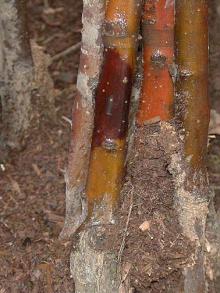See:
Apple (Malus spp.) - Crown and Collar Rot
Cause Phytophthora syringae, a soilborne fungus-like microorganism. It grows and is active at lower temperatures than the Phytophthora species that cause crown and collar rot of apple. This pathogen survives in soil and in fallen leaves. P. syringae occurs as a winter disease of nursery stock, especially on trees that have been harvested and are stored in either coolers or heeled-in outdoor sawdust beds. The organism can invade wounds caused by handling or pruning or through leaves and leaf scars. It can spread rapidly during cold, rainy periods. It produces zoospores that move passively with rain splash, surface water, and in water in soils near saturation. The disease also occurs frequently on flowering pear, Asian pear and white ash. It has also been found on chestnut, Chionanthus, Forsythia, flowering Prunus, Hawthorn, Jasminum, lilac, Mt. Ash and Zelkova.
Symptoms Cankers may occur anywhere on the stem of young plants but primarily on the lower stems and the base of tree trunks. Infection of apple bark tissues causes them to become necrotic, turn brown and give off an alcoholic odor. The leading edge of an active lesion may be irregularly mottled, merging imperceptibly into healthy tissue. In young nursery stock, cankers may appear slightly sunken and darker than normal. The color of the canker ranges from black to brown depending on tree taxa. May be difficult to find when dry. Wetting cankers can make them more noticeable. Cankers may girdle the tree producing a general lack of vigor, which may result in smaller leaves, reduced shoot growth, sparse, chlorotic foliage and premature autumn color.
Cultural control
- Prevent mechanical injury to trees, especially late in the season.
- Avoid leaving trees on the ground during rainy winter weather.
- Plant on well-drained sites.
- Avoid mounding soil around the trunks. Also, do not "heel-in" higher than the collar.
- Harvest highly susceptible nursery trees during dry weather.
- Remove and destroy all infected plants and plant debris.
Chemical control To minimize the development of resistant fungi, alternate or tank-mix fungicides from different groups that have different modes of action.
- Adorn at 1 to 4 fl oz/100 gal water plus another fungicide. Group 43 fungicide. 12-hr reentry.
- Aliette at 5 lb/100 gal water in September when leaves are still on the trees. Crabapple may need two (2) applications at this time 30 days apart. Do not use with adjuvants. Results in one study with crabapple (Spring Snow) were not too good but in another study found it the best of all products evaluated. Group P7 fungicide. 24-hr reentry.
- ArborFos is registered for tree injections. The number of capsules used is based on tree size. Group P7 fungicide.
- Monterey Garden Phos at 2.5 to 5 teaspoons/gal water as a foliar spray or at 16 fl oz/16 fl oz water plus 1 fl oz Pentra-Bark as a basal trunk spray. Group P7 fungicide. H
- Phospho-Jet is registered as a basal bark spray at 62.4 fl oz in 62.4 fl oz water plus 3 fl oz of Pentra-Bark. Spray first 5 feet of trunk including scaffold limbs until runoff. Group P7 fungicide. 4-hr reentry.
- Phostrol at 51 fl oz/74 fl oz water plus an organosilicone surfactant used as a basal bark spray. Also labeled for injection, see label for details. Group P7 fungicide. 4-hr reentry.
- Rampart at 1 to 3 quarts/100 gal water/A. Do not use copper products within 20 days of treatment. Can also be trunk injected. Group P7 fungicide. 4-hr reentry.
- Zonix at 45 to 76 fl oz/100 gal water. Can be sprayed on crop or injected into irrigation system. Short residual so may have to be used frequently for adequate results. 4-hr reentry.
References Grunwald, N. J., and Rolfe, K. 2009. Efficacy of registered and unregistered fungicides for control of stem rot on crabapple. Plant Disease Management Reports 4:OT016.
Waterhouse, G.M. and Waterston, J.M. 1964. Phytophthora syringae. CMI Descriptions of Pathogenic Fungi and Bacteria, No. 32. Surrey, England: Commonwealth Mycological Institute


